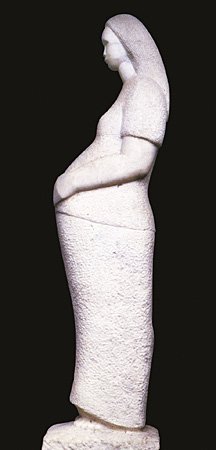Cultural Center of the Philippines
ENCYCLOPEDIA OF
PHILIPPINE ART
Kaganapan
(Fulfillment) / 1952 / Marble / 91.44 cm / Artist: Napoleon Abueva / Artist’s collection
Kaganapan, sculpted by Abueva in 1952 when he was a young student at the University of the Philippines, won the grand prize in the Art Association of the Philippines’ annual competition. This work was a breakthrough in Philippine sculpture. While the neorealist painters had banded together in defense of modernism that depicted genres in various approaches akin to cubism, impressionism, and fauvism, Abueva was practically alone in exploring the Neo-Realist viewpoint in three-dimensional art. During this period, norms of contemporary sculpture were still prevalently defined by the classicism of Guillermo Tolentino, on the one hand, and the realism of religious statuary art, on the other.
Kaganapan literally interprets the female reproductive function as woman’s fulfillment. Thus the artist reduces the female form into its most elemental. Frontally, the figure is a simple, vertically elongated oblong, softly widening in girth at the center. Heaviness and stability are emphasized by the enlarged arms and hands cuddling the abdomen. The monotony of verticality is broken by the horizontal lines gently suggesting the facial features, the sleeve line, and the blouse line. The woman’s head is rendered too small in proportion to the figure, with her slit eyes, high cheekbones, neat hair, and flat nose devoid of individualized characterization. The artist’s stylistic concern is to show the pensive, reflective form of an expectant mother in its simplest physicality.
The side view reveals that although form is minimized to its barest, the sculptor was sensitive to a realistic observation of a burdened spine and flexed abdominal muscles as posture suggests a ninth-month wait. The marble oeuvre has an overall texture of a roughly hewn finish repetitively wedged by a small, round chisel.
Written by Imelda Cajipe-Endaya
